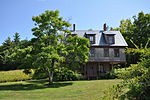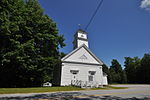Douglas Mountain (Maine)
Douglas Mountain or Douglas Hill is a small mountain in the towns of Sebago, Maine and Baldwin, Maine in the United States. It is named after early European settlers John and Andrew Douglas and was first settled by United States citizens in the 1830s. It is part of a small range called the Saddleback Hills on the west side of Sebago Lake. The peak of the mountain is the second highest point in Cumberland County, Maine In 1892, the mountain and surrounding area was purchased by Dr. William Blackman, a New York surgeon. He constructed a sixteen-foot stone tower at the summit, which provides striking panoramic views of Sebago Lake, the Presidential Mountains, and the city of Portland, as well as much of the Western Maine lakes and foothills. The Nature Conservancy later purchased and protected the land from development and later handed over its ownership to the town of Sebago for public recreation.
Excerpt from the Wikipedia article Douglas Mountain (Maine) (License: CC BY-SA 3.0, Authors).Douglas Mountain (Maine)
Douglas Mountain Road,
Geographical coordinates (GPS) Address Nearby Places Show on map
Geographical coordinates (GPS)
| Latitude | Longitude |
|---|---|
| N 43.8717 ° | E -70.6969 ° |
Address
Douglas Mountain Preserve
Douglas Mountain Road
04029
Maine, United States
Open on Google Maps






